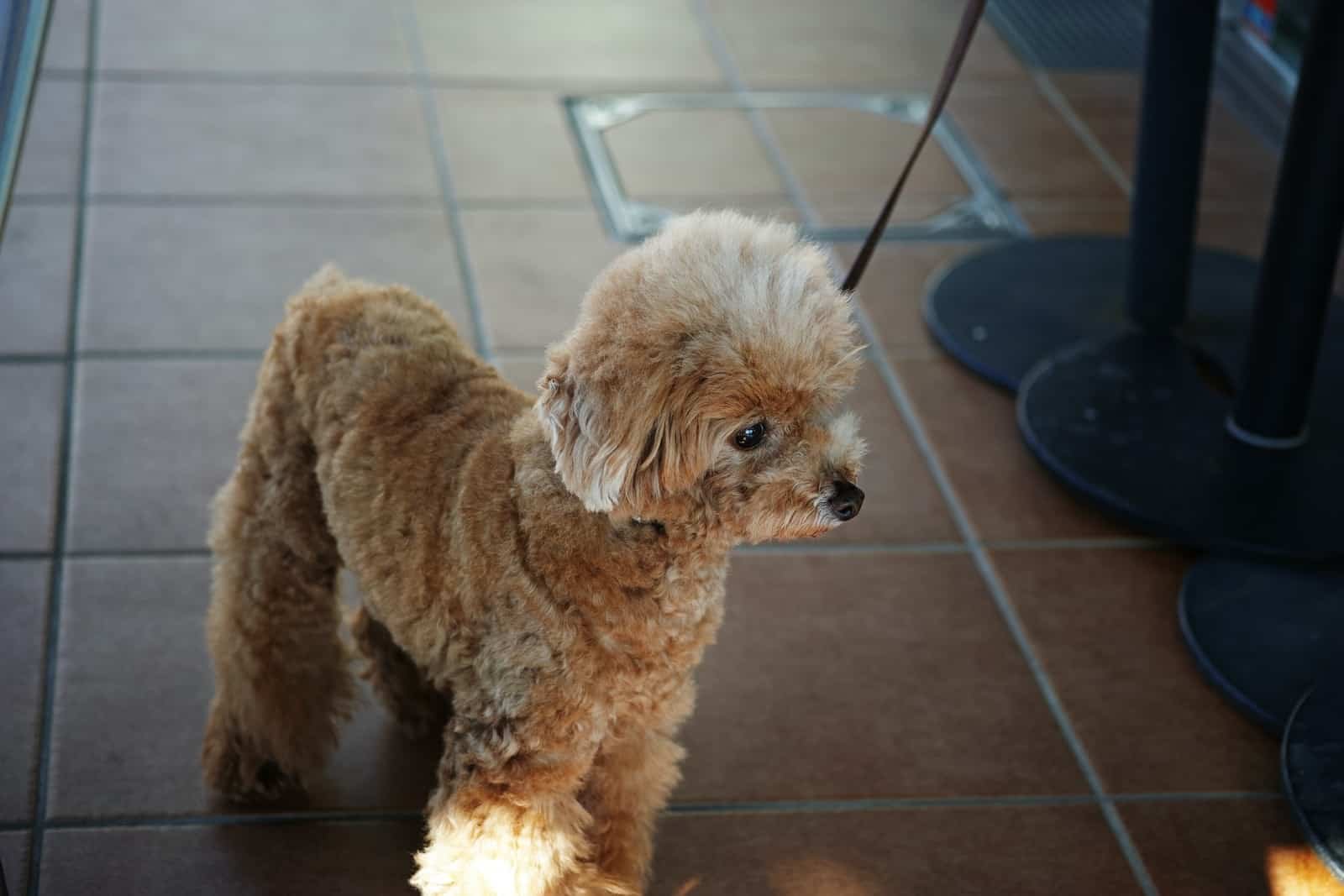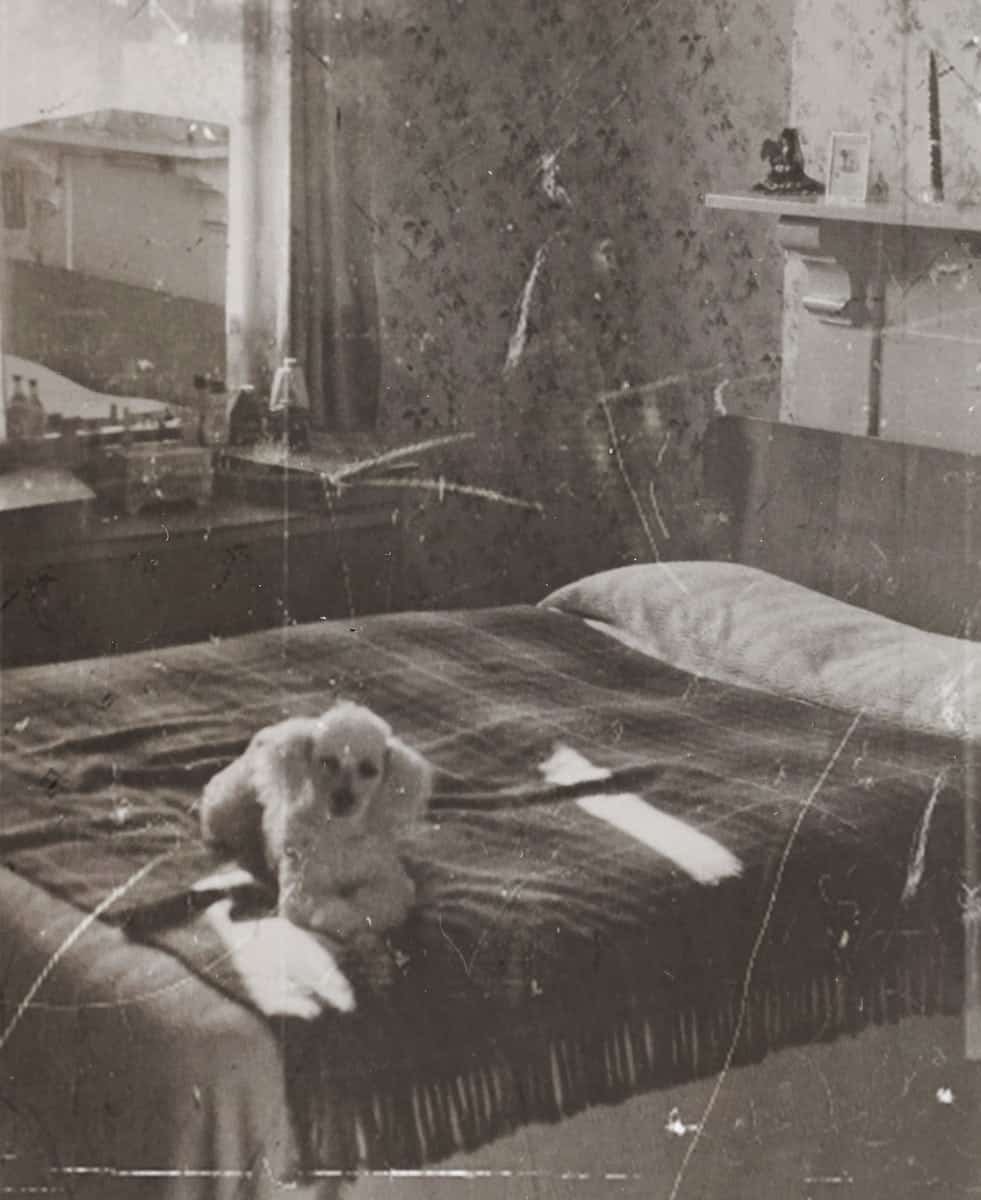
You may already be familiar with the various Poodle breed sizes, such as the Standard, Miniature, and Toy Poodles, all of which are recognized by the American Kennel Club (AKC). There are also some lesser-known varieties not recognized by the AKC, like the Giant/Royal Poodle and Teacup Poodle. The Moyen Poodle is acknowledged by European kennel clubs.
One intriguing and popular variety that major kennel clubs do not recognize is the Micro Poodle. These tiny, enchanting dogs captivate the hearts of many dog lovers, offering a lifetime of affection, intelligence, and loyalty.
From Our Experience: As poodle enthusiasts who have worked with hundreds of poodle owners and rescue organizations over the years, we’ve gathered real-world insights that go beyond textbook knowledge. The information in this article reflects both professional expertise and hands-on experience with poodles of all sizes and temperaments.
Origins and Breed History
The Micro Poodle is not officially recognized by the AKC and has been selectively bred from other Poodle sizes to create a smaller breed. It originated in Germany in the early 1900s, primarily as a companion dog for the nobility. Despite its unofficial status, the Micro Poodle has gained popularity among dog enthusiasts due to its adorable appearance and delightful personality.
Overview of Micro Poodles
Micro Poodles are a smaller variety of the Poodle breed and typically weigh between 4-6 pounds. These miniature dogs are recognized by kennel clubs as an official breed and have their own set of breed standards. Micro Poodles have a life expectancy of 12-14 years and make great pets for those who have limited living spaces or lead a more sedentary lifestyle. In this guide, we will explore the benefits of owning a Micro Poodle, from their exercise requirements to proper care and potential health issues to look out for.
About the Micro Poodle
Micro Poodles are the smallest among all varieties. While the Poodle has a vast breeding history, working as a hunting dog and water retriever, today’s pet owners see this breed as lapdogs and family dogs. These dogs are associated with wealth and sophistication now. Because of that, people breed these dogs in smaller variations so even more people can enjoy them. That’s where the Micro variety comes along. It’s a perfect companion for those living in smaller homes and apartments because of the size.
Like the Teacup Poodle, the Micro one measures less than nine inches and weighs less than six pounds. Micro Poodles can go even smaller than that, so they look like puppies throughout their life.
Despite the smaller body size, this dog still has a curly coat of hair that doesn’t shed often. That makes them the perfect breed for allergy sufferers! Allergic people won’t have to worry about intense reactions to this low-shedding dog.
People will also appreciate the grooming requirements these small dogs have. While these dogs still require daily brushing and regular baths and trims, their smaller bodies make them much easier to handle.
When bathing your tiny dog, do so using warm water. You need to keep this tiny animal warm because its body temperature drops quickly from a low body fat percentage!
Physical Characteristics and Traits
Micro Poodles are tiny dogs, even smaller than Teacup Poodles. They typically stand at only 3 inches tall at the withers (the highest point on the back) and weigh less than 10 pounds. Their compact size and lightweight nature make them well-suited for apartment living and easy to carry around.
These charming little dogs have short coats that come in various colors and patterns, including black, white, apricot, red, silver, and more. Like other Poodles, their fur is curly and hypoallergenic, making them an excellent choice for individuals with allergies.
If you’re looking to add a small and affectionate companion to your family, a micro poodle may be a perfect fit. As a mini version of the poodle breed, these dogs are typically 4-6 pounds in weight and stand at around 9-11 inches tall.
They have a moderate activity level that requires daily exercise, but also enjoy their downtime with their pet owner. They’re loyal and gentle temperament makes them a great fit for families with children. However, due to their curly and dense coat, grooming requirements are a must to prevent matting and tangling. While micro poodles are healthy dogs, there are a few common health issues to be aware of, such as retinal atrophy and patellar luxation.
Size and Weight
When choosing a dog, size and weight are essential factors to consider. These factors play a significant role in determining how easy it is to care for the dog and what kind of exercise or living space is required. With micro poodles, size and weight are critical.
Micro poodles are one of the smallest dog breeds available, weighing only 4-6 pounds and measuring 6-8 inches in height. Compared to standard-sized poodles, miniature poodles, and toy poodles, micro poodles are significantly smaller. They are a great choice for pet owners who prefer a dog that is easy to carry or handle.
Choosing a reputable breeder is crucial to ensure that your micro poodle is healthy. A reputable breeder is one that breeds dogs based on official breed standards and avoids breeding practices that could lead to health issues later in life.
When choosing a breeder, it’s essential to look for one who can provide genetic testing for any potential health concerns that could affect your micro poodle, including patellar luxation, hip dysplasia, retinal atrophy, and dental issues.
In summary, micro poodles are the smallest dog breed and an ideal pet for those who prefer a tiny dog. Choosing a reputable breeder is also essential to ensure good health and prevent breeding practices that could lead to health issues.
Temperament and Personality
Micro poodles are known for their exceptional temperament and personality. They are intelligent, loyal, and dedicated to their families and owners, making them a popular choice for pet owners. Their obedience and strong desire to please make them an ideal breed for obedience training.
One of the most notable traits of micro poodles is their affectionate nature. They crave bonding time with their owners and love to be pampered with attention and affection. They are playful, energetic, and curious. However, they have a delicate psyche and sensitive nervous system and require proper care to thrive.
Micro Poodles have similar breed traits as Standard, Miniature, and Toy breeds. It is an intelligent breed that loves to play around and learn from its owners. These dogs love attention and are prone to separation anxiety when left alone. That’s why owners must make more time to care for these dogs and provide a lot of attention and bonding time.
Although they are small, micro poodles are predators at heart, and their instincts drive them to explore and hunt. As much as they are playful, pranks should not be excused, as they can disrupt their sensitive psyche.
Because of the dog’s small size, it won’t require regular exercise as its bigger varieties. It prefers more bonding time with its owners through cuddles! This dog remains a kid at heart and will love playing around, but be careful!
Micro Poodles are not family dogs. Even if you have an affectionate family, these dogs are tiny, so if you have children or other dogs, these dogs are at risk of injuries from mishandling and rough play.
Overall, micro poodles are intelligent and duly devoted dogs, with an understanding of their place in the family hierarchy. They have an obedient personality and a high level of bonding with their owners. If you are looking for a pet that will provide an affectionate and loyal companion, a micro poodle is an excellent choice.
Poodle Mixes
Poodle mixes, or “Doodles,” have become increasingly popular in recent years. The Poodle is often crossbred with other breeds such as Chihuahuas, Cocker Spaniels, Lhasa Apsos, Shih Tzus, Maltese, and Yorkies, to name a few. These mixed breeds often retain the intelligence, low-shedding coat, and friendly nature of the Poodle while exhibiting unique traits from the other parent breed. However, it is essential to note that the Micro Poodle is a product of selective breeding within the Poodle breed and not a crossbreed with another breed like the Chow Chow.
Care and Grooming
Micro Poodles require regular grooming to maintain their curly coats and prevent matting. They should be brushed daily and professionally groomed every 6-8 weeks to keep their coats clean and healthy. Their small size makes them prone to dental issues, so it is crucial to brush their teeth regularly and provide dental chews or toys to help maintain oral hygiene.
Grooming Requirements
Grooming a teacup poodle can be quite a complex task due to their thick and curly coat. This breed requires regular grooming to maintain their beautiful, soft coat. If the coat is left ungroomed, it can become matted and tangled easily. Therefore, it is essential to groom them regularly to prevent this from happening.
Teacup poodles require daily brushing to remove any dead hairs from their coat and to keep it looking neat and tidy. This daily grooming not only helps in maintaining their coat but also helps with other issues, like preventing mats, tangles, and skin irritations. Teacup poodles are not only hypoallergenic, but they also shed little hair. Daily brushing helps in keeping their coat clean and smooth.
One of the other concerns with teacup poodles is tear staining. Tear stains can form under their eyes, making them look unsightly. It is important to monitor these tear stains and use tear stain remover to reduce them.
Besides daily brushing, teacup poodles require regular grooming every four to six weeks, depending on how fast their coat grows. Combing is also suggested during the weeks in between grooming sessions, which helps to keep their coat clean and free of tangles. The thick coat of this breed requires a lot of attention and care, but it is worth it to maintain their beautiful look.
Grooming a teacup poodle is a necessary task to keep them healthy and happy. With daily brushing, regular grooming every 4-6 weeks, combing, and tear stain removal, you can ensure that they remain clean, tangle-free, and well-groomed. A little effort and attention to their grooming needs will keep them looking and feeling their best.
Activity Level
Micro poodles are a small and delicate breed, but that doesn’t mean they don’t need exercise and mental stimulation. While they may not require an intense physical activity regimen, they need some amount of exercise every day to maintain good health.
Adult micro poodles do well with two short walks of up to 10 minutes and around 30 minutes of play per day. This exercise routine will help keep them fit while allowing them to burn off excess energy and improve their mental wellness. It’s important to avoid overexerting your pet because micro poodles have fragile bodies and are easily injured by even moderate tugs.
When exercising your micro poodle, it’s essential to be mindful of their small size. This means avoiding letting them jump or fall off anything and keeping them on a good harness instead of a leash. It’s important to be watchful and keep them away from high-risk activities that can cause injuries.
The mental stimulation of micro poodles is just as important as physical exercise. Simple activities like playing with toys and providing them with puzzle games can help keep them engaged and enhance their cognitive health. It’s important to incorporate such activities into their daily routine to keep their minds sharp.
In conclusion, while micro poodles do not require extensive amounts of exercise, it is vital to ensure they get some amount of both physical activity and mental stimulation daily. With vigilance and care, they can live healthy lives and stay happy for years to come.
Daily Exercise Needs
While micro poodles are relatively small, they still require an appropriate amount of daily exercise to maintain their health and wellbeing. As a pet owner, it is important to provide your furry friend with regular physical activity to keep them healthy and happy.
Micro poodles rarely require an extensive exercise routine, but they need daily activity to stay in shape. A typical adult micro poodle should have a minimum of 30 minutes of exercise per day, while a puppy should have short, 5 to 10 minutes of exercise sessions spread throughout the day. As they grow, you can accumulate the duration of their activity sessions.
When giving your furry friend physical activity, it is important to vary the type of physical activity to provide them with unique skills and challenges. Walking is a great start for physical activity, but longer walks and playtimes should gradually be incorporated. For adult micro poodles, two short walks of 15 minutes a day will suffice, while puppies may require shorter, more frequent walks.
Mental stimulation is also incredibly important for micro poodles to keep them occupied and happy. Engaging with your pet through mentally stimulating activities, such as playing hide-and-seek and puzzle games, can help to prevent boredom and destructive behaviors.
Overall, providing your micro poodle with an appropriate exercise amount and variety of physical activities can help them maintain healthy lives and prolong their life expectancy. By escalating the duration and intensity of their exercise, you can ensure they receive the amount of physical activity they require.
Feeding Your Micro Poodle
Feeding your micro poodle a well-balanced diet is essential to maintaining their health and longevity. As a pet owner, it’s crucial to provide your furry friend with proper care to ensure they live a healthy life.
Dry kibble is the primary source of food for micro poodles because of its convenience in portion control and storage. However, it’s important to monitor the amount of calories your pet consumes per day and make sure it aligns with their activity level and weight.
Supplements such as fatty acids can aid in maintaining good health. Finally, since micro poodles are prone to hypoglycemia, monitoring their blood sugar levels is recommended to help sustain a healthy and happy pup.
Dry Kibble as the Primary Diet Source
Dry kibble is the primary source of nutrition for Micro Poodles, and it is important to choose a high-quality, specially planned food for toy breeds. By providing your Micro Poodle with a balanced and nutritious diet, you can help ensure that they live a healthy and happy life.
A high-quality dry kibble will provide your Micro Poodle with all the nutrients they need to thrive, including vitamins, minerals, and protein. Look for a brand that uses high-quality ingredients and avoid fillers like corn or wheat. The food should also be formulated specially for toy breeds, as their nutritional needs differ from larger dogs.
The recommended daily calorie intake for a Micro Poodle is between 300-500 calories per day, depending on their age and activity level. This should be divided into four small meals throughout the day, as small dogs are prone to hypoglycemia if they go too long without eating. Hypoglycemia is a condition that causes low blood sugar levels in small dogs, which can lead to weakness, seizures, and even death.
To avoid hypoglycemia, it is important to stick to a regular feeding schedule and avoid giving your Micro Poodle too many treats or meals outside of their regular feeding times. Offering them high-calorie food or treats can also increase their risk of the condition.
In summary, feeding your Micro Poodle high-quality, specially planned dry kibble in four small meals throughout the day, is essential to providing them with proper nutrition and avoiding the risk of hypoglycemia. Choose a brand that is specifically planned for toy breeds and avoid overfeeding them with too many treats or meals outside of their scheduled feeding times.
Amount of Calories Per Day
Proper nutrition is essential for a Teacup Poodle’s healthy life. A well-balanced diet that includes the right amount of calories is critical for maintaining a Teacup Poodle’s optimal health and weight. The amount of calories required for a Teacup Poodle’s diet depends on its age and activity level.
An adult Teacup Poodle requires around 250 calories per day, which should be equally divided into three meals. This amount of calories is approximately equivalent to half a cup of dry food, which is a sufficient amount to maintain their energy levels and weight. However, it is essential to note that each Teacup Poodle is unique, and this amount may vary slightly based on their individual characteristics.
For a five-month-old Teacup Poodle, the recommended amount of dry kibble is 5-6 pieces per meal, four times a day. This feeding schedule helps to ensure that the Teacup Poodle receives an adequate amount of food throughout the day, which is crucial for their growth and development.
It is crucial to avoid overfeeding your Teacup Poodle to prevent obesity, which can cause several health issues. Feeding your Teacup Poodle with premium dry food, wet or canned food, fresh meats, and vegetables will provide them with the nutrients and prevent them from gaining excessive weight.
In conclusion, providing your Teacup Poodle with the right amount of calories and proper nutrition is crucial for their healthy lives. Feeding them with the recommended amount of dry kibble and adhering to a balanced feeding schedule will ensure that they receive the nutrients they need while maintaining an ideal weight.
Supplements for Optimal Health
Just like humans, micro poodles need a well-rounded diet to stay healthy. While a balanced diet provides all the nutrients they need, adding a supplement can help enhance their overall health and well-being.
One excellent supplement to consider is fatty acids. These supplements reduce inflammation, improve brain function, and promote healthy skin. Fatty acids can also improve your pet’s immune system, joint health, and coat. Vitamins and minerals such as vitamin C and E, calcium, and iron can be beneficial for maintaining strong bones and teeth and regulating healthy blood cells.
Apart from that, probiotics are also a great addition to your pet’s diet as it aids in digestion and promotes a healthy balance of bacteria in their gut. By adding probiotics to their food, you can help your pet’s digestive system to function correctly and break down the food they eat better.
Last, if your pet is suffering from joint pain or related issues, consider adding glucosamine and chondroitin sulfate supplements to their diet. These supplements work as natural remedies to ease pain, inflammation, and stiffness in their joints. This will not only provide your pet with relief, but also promote the healthy growth of their joints.
In conclusion, incorporating these supplements into your micro poodle’s diet can help maintain optimal health, vitality, and overall happiness. However, we recommend talking to your veterinarian first before introducing any supplements to your pet. They can help in deciding the correct dosage and frequency, ensuring your pet leads a healthy life.
Monitoring Blood Sugar Levels
As a micro poodle owner, it is important to monitor your pet’s blood sugar levels to prevent hypoglycemia, a condition that occurs when your dog’s blood sugar drops too low. Teacup poodles, in particular, are highly susceptible to hypoglycemia because of their small size, underdeveloped liver and pancreas, and sensitive digestive systems.
To prevent this condition from occurring, it is vital to check your puppy’s blood sugar levels often. This can be achieved by using a glucose meter and test strips, which can be easily purchased at a local pharmacy or online. With these tools, you can get an accurate reading of your pet’s blood sugar levels.
To establish a baseline glucose level for your pet, it is recommended to take a reading during a normal activity period. This will help you understand what levels are typical and healthy for your pet. If you notice any significant changes in your pet’s glucose levels, it is recommended to contact your veterinarian immediately.
By monitoring your micro poodle’s blood sugar levels regularly, you can help prevent hypoglycemia and ensure that your pet lives a healthy and happy life. So invest in a glucose meter and test strips, and establish a routine to check your pet’s blood sugar levels as part of your daily pet care efforts.
Health Considerations
Micro Poodles may face some health issues due to their small size, such as dental problems, luxating patellas, and tracheal collapse. Regular veterinary check-ups and preventative care are essential to maintain their overall health.
A balanced diet and proper weight management can help prevent obesity-related health issues. It is also crucial to be cautious of hypoglycemia in Micro Poodles due to their small size and metabolism. Providing small, frequent meals can help maintain stable blood sugar levels.
Common Health Issues
As a micro poodle owner, one of the most important things you can do is to stay informed about your pet’s potential health risks. By being vigilant and taking preventative measures, you can help ensure that your furry friend lives a long and healthy life. Here are some common health issues to be aware of when it comes to micro poodles:
- Progressive Retinal Atrophy (PRA) is a genetic disease that may cause blindness in micro poodles. Unfortunately, there is no cure for PRA. However, early diagnosis and treatment can help to slow down the progression of the disease. If you notice any changes or issues with your pet’s vision, get them checked out by your veterinarian.
- Dysplasia: Micro poodles are prone to different dysplasia, such as hip, elbow, and patella dysplasia. These conditions are caused by the abnormal formation of the bones and joints, leading to pain, limping, and ultimately, arthritis. To prevent or manage dysplasia, feed your pet a healthy diet, provide regular exercise, and avoid obesity.
- Hypoglycemia: Micro poodles can experience episodes of low blood sugar or hypoglycemia, which can cause seizures and other serious health problems. To prevent hypoglycemia, make sure your pet gets enough to eat and monitor his or her blood sugar levels regularly.
- Heart defects: Micro poodles are susceptible to heart defects, which can include issues such as mitral valve disease and congenital heart disease. Regular check-ups with your vet are important to monitor your pet’s heart health and catch any potential issues early on.
- Patella luxation is a condition where the kneecap dislocates from its normal position, causing pain and limping. To prevent this condition from developing, ensure that your pet maintains a healthy weight, provide mental stimulation and regular exercise to strengthen their muscles.
As a responsible pet owner, it’s essential to monitor your micro poodle for signs of any health concerns and schedule regular check-ups with the vet. By doing so, you can help ensure that your pet stays healthy, happy, and by your side for many years to come.
Before committing to a Micro Poodle and its breeding activities, you must learn about the different health risks and prepare ahead. As long as you meet your Micro Poodle’s care requirements and take it to the veterinarian for follow-up checkups, you have the perfect companion who will love you for life.
Benefits of Owning a Micro Poodle
When finding the perfect lapdog and companion, look no further than the Micro Poodle. This adorable breed is known for its love of people, making them the ideal furry addition to any family.
Aside from making excellent lapdogs, Micro Poodles has a lively and engaging personality with a keen sense of alertness. Despite their small size, they make great watchdogs because of their ability to alert their owners to any disturbances or strangers around the house.
One of the many benefits of owning a Micro Poodle is their small litter size, making them even more desirable to their owners. As a result, their owners have more opportunities for bonding time and one-on-one interaction with their furry friends.
Overall, these miniaturized poodle breeds are perfect for those seeking a true companion animal that brings joy and happiness to their lives. They have a lovable personality that keeps their owners engaged and entertained for hours on end. So why not welcome a Micro Poodle into your family today and start enjoying all the benefits they offer? You won’t regret it.
Finding a Reputable Breeder
When looking for a Micro Poodle, it is essential to find a reputable breeder who prioritizes the health and well-being of their dogs. Reputable breeders will perform genetic testing on the parent dogs to reduce the risk of passing on inheritable diseases. They will also provide you with detailed information about the puppy’s lineage, health records, and any potential health concerns.
Avoid purchasing a Micro Poodle from pet stores or untrustworthy sources, as these puppies may come from puppy mills and have undisclosed health issues. Responsible breeders will encourage you to visit their facility, meet the parent dogs, and ask questions about their breeding practices.
Adoption and Rescue Options
While Micro Poodles are less common in shelters and rescue organizations than larger Poodle varieties, it is still possible to find one in need of a loving home. Adoption is a great option for those looking to provide a second chance to a dog in need.
Reach out to Poodle-specific rescue groups, as they may have Micro Poodles or Poodle mixes available for adoption. Adopting a dog from a rescue or shelter can be a rewarding experience and can also help ease the overcrowding issues that many shelters face.
Living Needs
The Micro Poodle requires minimal food intake. These dogs don’t grow quick, so they only eat half the amount of calories compared to larger breeds. They also require less grooming than other breeds.
This dog’s coat sheds less than most other breeds, which makes it ideal for allergy sufferers. The coat is easy to groom and maintain, making it a great choice for pet parents.
Because of its small size, it won’t need a large living space. However, ensure that your home has enough room for your dog to run around freely without bumping into furniture.
Conclusion
Micro Poodles are enchanting little dogs that make excellent companions for those seeking a small, intelligent, and affectionate pet. Though not recognized by major kennel clubs, their popularity continues to grow due to their delightful personalities and charming appearance.
As with any breed, proper care, grooming, exercise, and training are essential to ensure a happy, healthy, and well-adjusted Micro Poodle. By choosing a reputable breeder or considering adoption, you can welcome a loving Micro Poodle into your family and experience the joy of having one of these tiny, fairy tale-like dogs as a lifelong companion.







